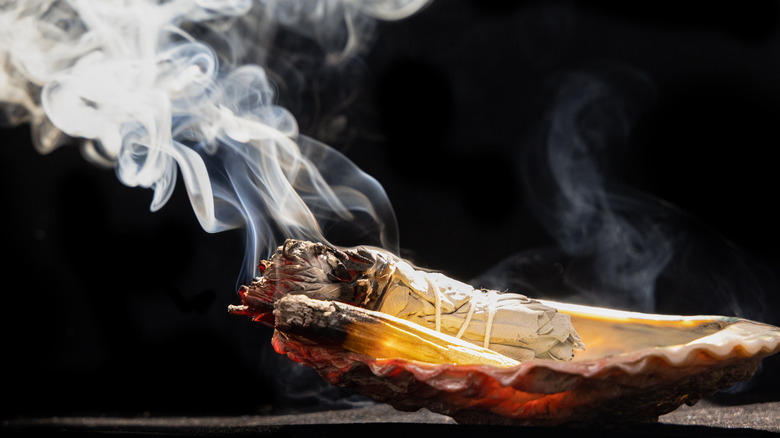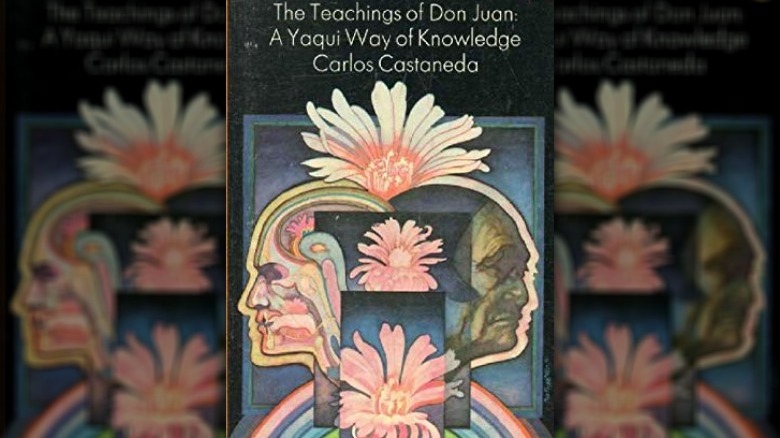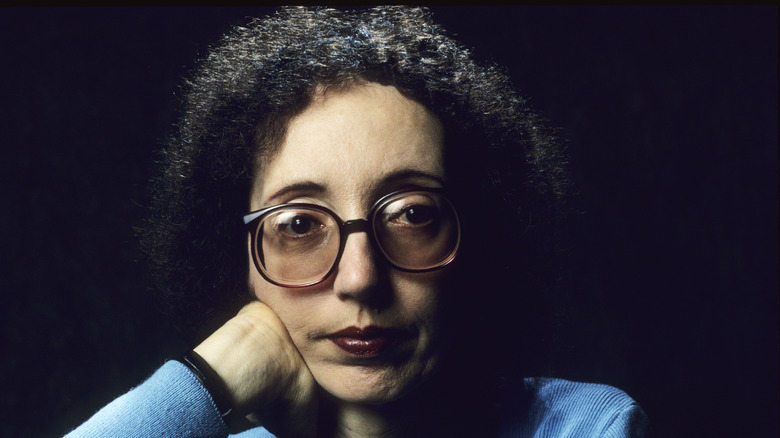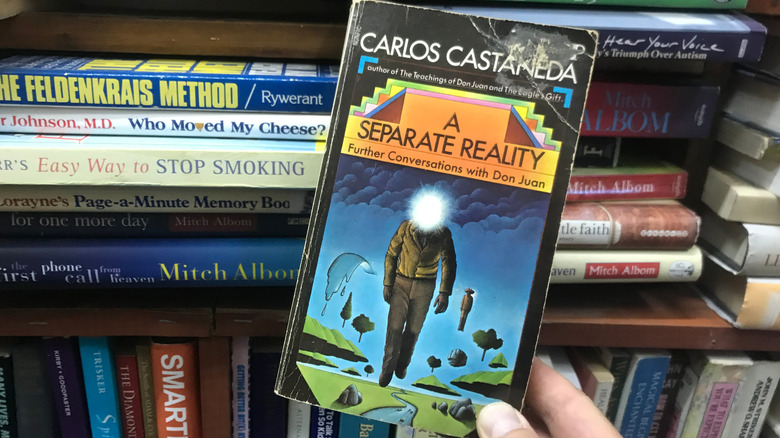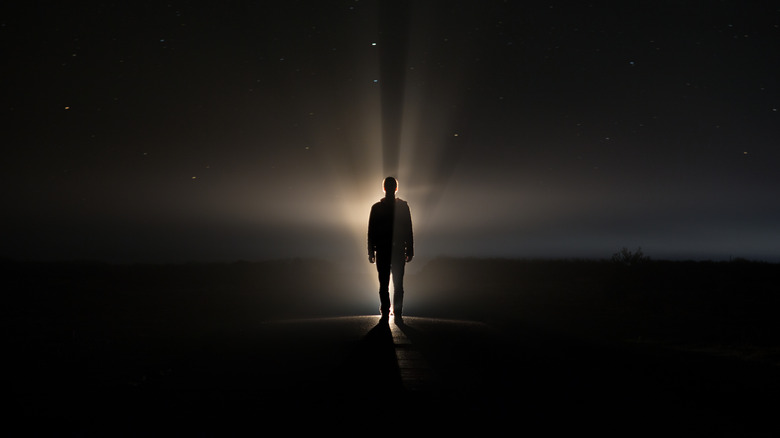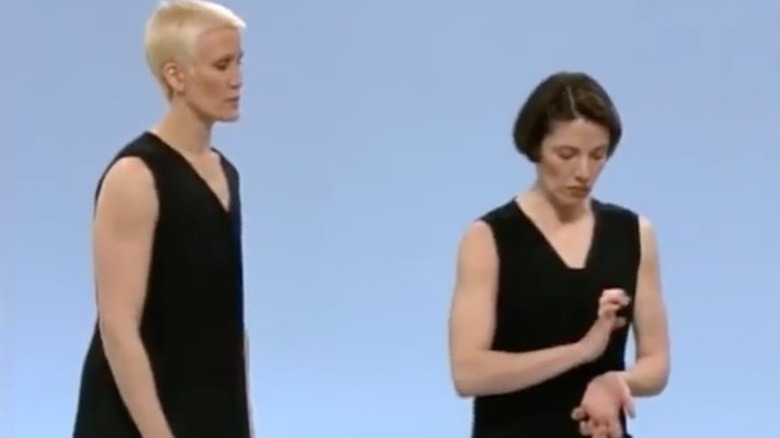The Untold Truth Of Carlos Castaneda
Today, the book industry at its most successful is also a well-oiled hype machine, with the power to propel a young author into the literary limelight and make them a household name overnight. Not only do books become personal favorites, but writers themselves become cult icons with fans as loyal and devoted as those of the biggest pop stars.
In the 1960s and '70s, one young writer who found themselves catapulted to literary stardom was Carlos Castaneda, whose mystical and life-affirming writing saw him quickly elevated to the level of sage among open-minded readers in America and beyond.
As noted by Straight Dope, much of the appeal of Castaneda's work rests on the supposed reality of the events on the page. Castaneda's first book, "The Teachings of Don Juan: A Yaqui Way of Knowledge," was submitted by the young Peruvian as his MA thesis while studying anthropology at the University of California, Los Angeles (UCLA), with The New York Times noting that the work — and those that followed — read like "field notes" chronicling actual encounters and real-life spiritual teachings. Castaneda's publishers categorized his work as non-fiction, and his readers lapped it up as such, believing Castaneda's adventures in spirituality and psychedelic drugs to be the real deal. But as critics and readers later found out, not everything in Castaneda's work was quite as it first appeared.
Godfather of the New Age
Carlos Castaneda's success began in 1968, when "The Teachings of Don Juan" became a bestseller. Seemingly tapping into the decade's countercultural revolution and the increasingly widespread use of psychoactive drugs, the book offered a series of dialogues between a young character, Carlos — a seemingly autobiographical rendering of the author, though never stated explicitly in the text — and a veteran Yaqui sorcerer whom Carlos meets in Mexico, named don Juan Matus. The book was instantly popular, and was quickly followed by sequels at the behest of Castaneda's publisher, according to Salon. Castaneda became a celebrity, with some of the biggest figures of the day, including John Lennon, publicly praising the writer and his work.
But not everyone was convinced. While the anthropologist Paul Riesman wrote positively of Castaneda's first three books in a profile in The New York Times Book Review in 1972, the piece was in fact the second the Review commissioned. The first, shelved article was written by Weston La Barre, a renowned expert on Native American culture and the use of peyote as a ceremonial drug. Le Barre claimed that, rather than the credible non-fiction that many critics and readers took them to be, Castaneda's work was in fact "pseudo-profound deeply vulgar pseudo-ethnography" (via Salon). It would be years before Le Barre's dismissal of Castaneda's work became widely known.
Carlos Castaneda: fact or fiction?
Though the works of Carlos Castaneda appearing to chronicle his own spiritual growth received widespread acclaim from many reviewers and academics, within a few years a vocal number of critics and fellow writers began to air their doubts that the events Castaneda depicted in the books were real, or that his now-famous shaman, don Juan, was a real person at all.
"Is it possible that these books are nonfiction?" asked the novelist Joyce Carol Oates (pictured) in 1972, in one of the first notable cases of a public figure questioning, albeit politely, the veracity of Castaneda's claims (via Los Angeles Times). "I realize that everyone accepts them as anthropological studies, but they seem to me remarkable works of art, on the Hesse-like theme of a young man's initiation into 'another way' of reality. They are beautifully constructed. The dialogue is faultless. The character of Don Juan is unforgettable. There is a novelistic momentum."
But of course, Castaneda's writing continued to attract new readers, while his devoted audience looked to discredit his distractors, including the academic Anton F. Kootte, whose survey of those who questioned the authenticity of Castaneda's work, titled "A Critical Look at Castaneda's Critics," was published in The Journal of Mind and Behavior in 1984 (via JSTOR). Kootte claimed that those who painted don Juan as a fictional creation and Castaneda as nothing more than a talented hoaxer offered arguments that were "lacking in logical and empirical proof," and that critics of Castaneda's claim to have truly been trained by a Yaqui sorcerer had failed to debunk it.
Was Carlos Castaneda a conman?
While experts familiar with Yaqui culture increasingly sought to discredit Castaneda's account of his spiritual journey under the guidance of don Juan — asking, for example, why authentic Yaqui language is never found in Castaneda's writing, as one might expect (via Reality Sandwich) — others pointed out that even the basic details of Castaneda's life were impossible to pin down.
As noted by the Los Angeles Times, details of Castaneda's birthdate and even his nationality differed wildly in a range of publications, with a directory of authors listing him as Brazilian, with a birthdate of December 25, 1931, while immigration documents had him registered as being six years older, and listed Peru as his country of origin, with still other sources giving his birth year between 1915 and the late '30s.
While Castaneda's fans seemingly lapped up the mystery around the cult writer, others saw the absence of such hard and fast facts as proof that he was little more than a conman, who had been enabled in his fast-and-loose approach to the truth by academic publishers who had failed to secure evidence to validate what was being promoted as a real-world anthropological study.
But in the eyes of many literary critics, Castaneda was saved by one thing: the quality of his writing, which, whether fact or fiction, was undeniably insightful and spiritually engaging. Per the Los Angeles Times, even Richard de Mille, one of Castaneda's greatest critics, admitted the writer "wasn't a common conman, he lied to bring us the truth. ... This is a sham-man bearing gifts."
Castaneda retreats from the public eye
Today, when self-promotion is the name of the game, few professional writers enjoy the luxury of stepping out of the limelight and letting their work speak for itself. Whether by building an online presence, attending workshops and festivals, or giving interviews, publishers expect their authors — unless they enjoy the mystique of anonymity afforded to Thomas Pynchon or Elena Ferrante — to actively promote their own writing.
Castaneda, however, succeeded in disappearing from the pubic eye at the height of his popularity, walking away in 1973. According to Salon, such action was seemingly in keeping with the teachings of his 1971 book "A Separate Reality," which preached the importance of "becoming inaccessible" and "erasing personal history," but in fact, more cynical motivation may have underpinned Castaneda turning his back on fame.
Also in 1973, Castaneda was the subject of an in-depth cover feature in Time magazine, exposing many of the contradictions of his biography to a wide readership and transforming prior doubts about whether he was anything more than a liar into a hot topic among America's literatti. Per Salon, after the article's publication Castaneda began to refuse interviews, and wouldn't appear in public again for more than 20 years. Instead, Castaneda was building in private what the same source describes as an "alternative family," which would in time evolve into a dark and disturbing cult.
A New Age Cult and suspicious deaths
As reported in Salon, in the months following the publication of Castaneda's Time magazine feature, the writer left his wife of 13 years and his adopted son. He bought a compound on Pandora Avenue in Westwood, Los Angeles, where the writer, who was now in his late 40s, lived with three young female "disciples," Regine Thal, Maryann Simko, and Kathleen Pohlman.
In a decisive break with the writer's past, the three women, known as the "witches," would soon replace don Juan, the teacher who first made Castaneda famous, as the principal characters in his writing. But while Castaneda would continue to publish works on "sorcery," the writer increasingly turned toward offering workshops and seminars along the lines of many New Age movements. His product was a physical exercise regime called "Tensegrity," which Castaneda claimed to have inherited from a shamanic lineage going back 25 generations. The movement gained thousands of followers, while the writer channeled the profits from his live sessions — and, increasingly, the sale of videos (seen above) — through his new corporation, Cleargreen.
Thus Castaneda spent the last decades of his life as a guru who had escaped the public eye. However, Castaneda was again in the headlines following what the Los Angeles Times describes as a "hushed" death in April 1998, when, per Salon, several of the women closest to him went missing, including Patricia Partin, Castaneda's "adopted daughter as well as his lover." Insiders believed that the women, following Castaneda's teachings, had committed suicide. Partin's remains were eventually discovered in February 2006. Four of Castaneda's "witches" have yet to be found.
